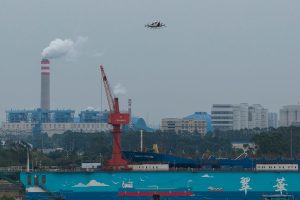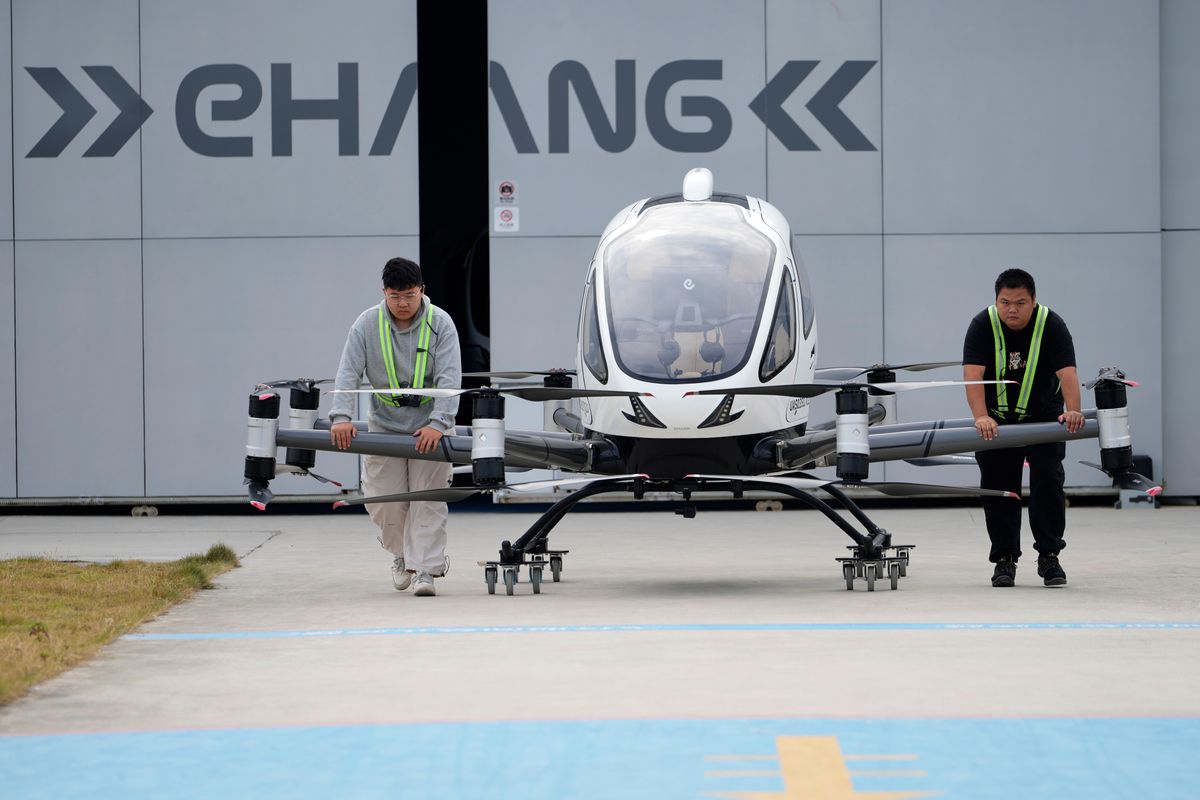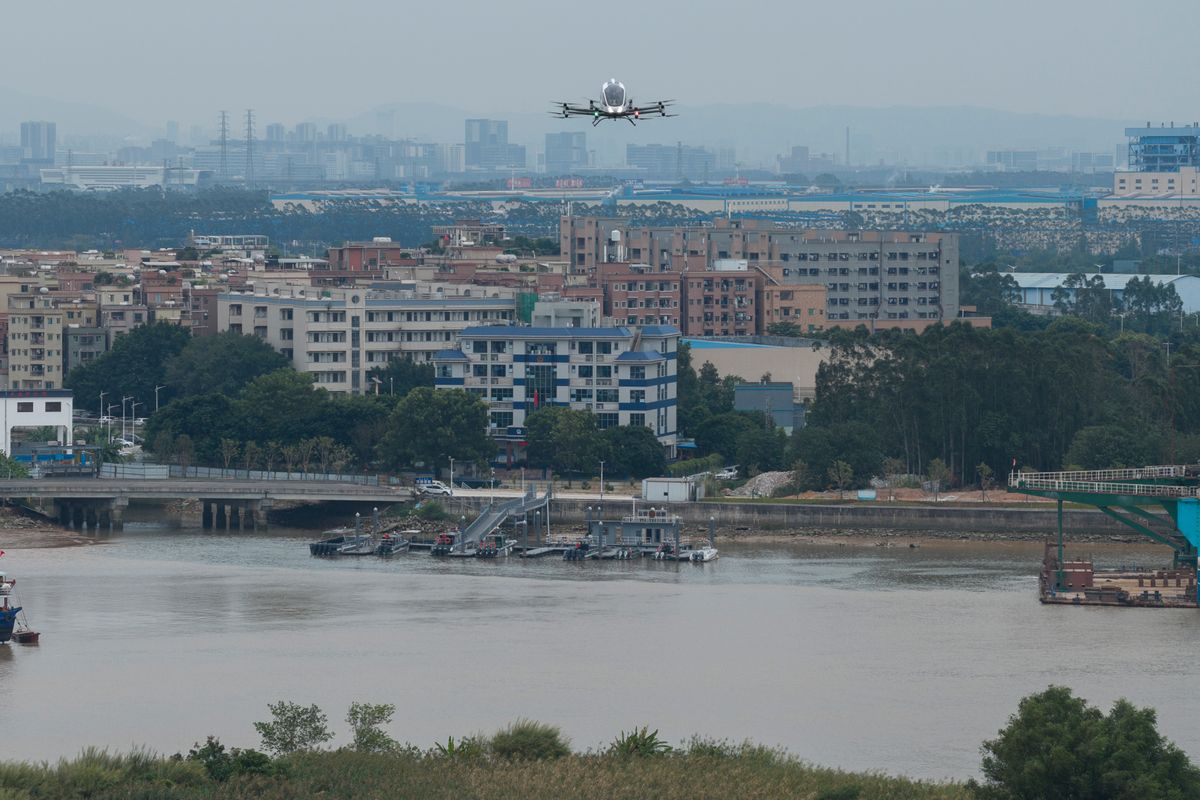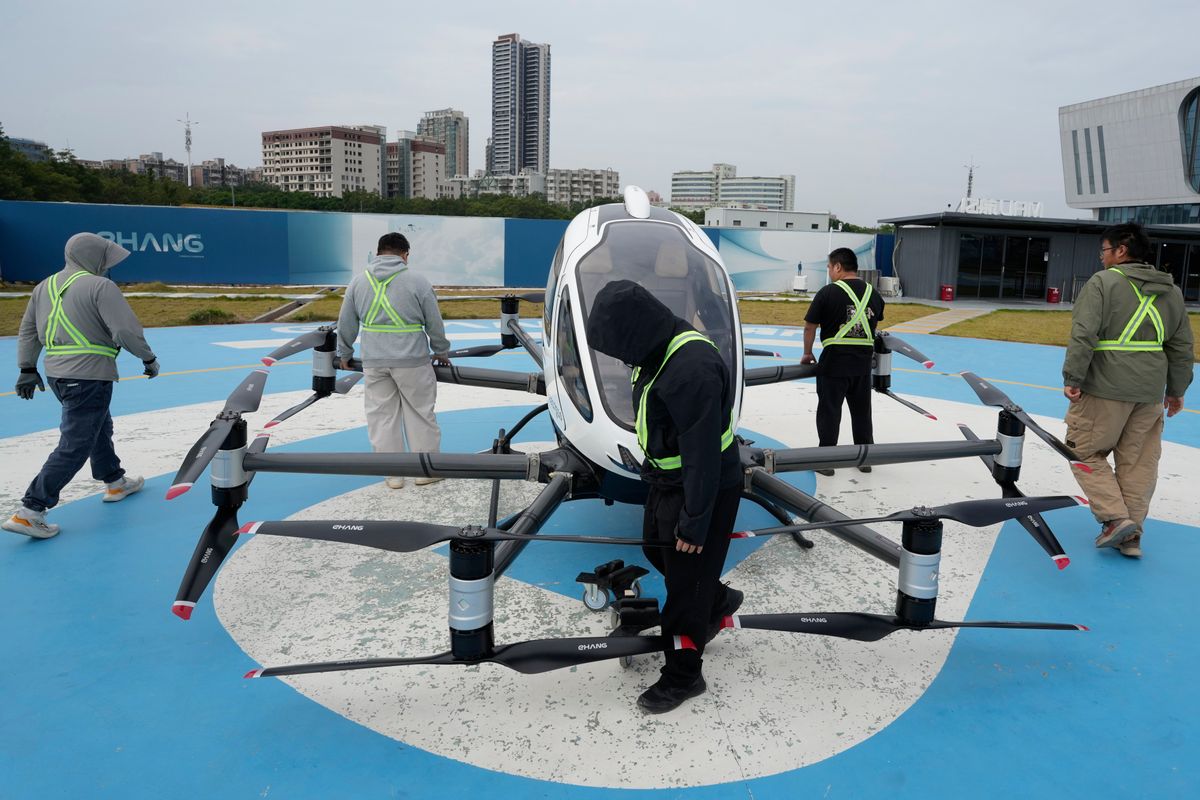HONG KONG (AP) — An unmanned, oval-shaped craft from flying taxi maker EHang hovers, whirring noisily like a mini-helicopter over a riverside innovation zone on the outskirts of the southern Chinese business hub of Guangzhou, part of a trial of a mini-flying taxi that once might have been found only in sci-fi films.
In nearby Shenzhen, food-delivery drones already are part of daily life and a novelty attraction for tourists, even if such services cost more. In the waterfront park surrounded by high-rises, Polish tourist Karolina Trzciańska and her friends ordered bubble tea and lemon tea by phone, just to give it a try. Their drinks arrived via a drone buzzing through the drizzle about 30 minutes later.
“This is the first time I’m seeing something like this, so it was super fun to see the food being delivered by the drone,” she said.
Such businesses are growing quickly with support from the government, though the take off of the so-called “low-altitude economy” faces obstacles such as strict airspace controls and battery limitations.
Activities in airspace below 1,000 meters (about 3,280 feet) accounted for business turnover worth 506 billion yuan ($70 billion) in 2023, about 0.4% of China’s economy. By 2035, it’s expected to hit 3.5 trillion yuan (about $490 billion), said Zhang Xiaolan, a researcher at the State Information Center, a think tank affiliated with China’s main planning agency.
Flying cars are in the making
Guangdong province, home to drone giant DJI with an estimated 70% of the global commercial drone market, leads in development of the low-altitude economy, followed by wealthy eastern coastal provinces Jiangsu and Zhejiang, near Shanghai, according to a report by a research unit of the Chinese Academy of Sciences, Peking University, and other institutions.
Other big players in Guangdong include EHang, logistics company SF Express’s drone arm Phoenix Wings, and automaker XPENG’s flying car unit ARIDGE.
In October, Guangdong announced it plans to speed up construction of flight service stations and platforms to facilitate airspace operations and will support locally issued discount vouchers for low-altitude tourism.
Its technology and financial hub Shenzhen has launched a 15-million-yuan ($2.1 million) award for companies that earn certifications required for passenger eVTOLs, short for “electric vertical take-off and landing” vehicles that lift off the ground like helicopters, among other incentives.
China’s Civil Aviation Administration has granted certificates allowing EHang to offer commercial passenger services with its pilotless eVTOL, a low-altitude aircraft that can reach speeds of 130 kph (81 mph) with a maximum range of 30 kilometers (19 miles).
EHang hasn’t launched commercial routes, but its vice president, He Tianxing, says it aims to start with aerial sightseeing services. The company has been building takeoff and landing sites in 20 Chinese cities over the past two years. He expects aircraft of various companies will be flying multiple routes, possibly after five years.
He envisions eventual citywide networks using the rooftops of malls, schools and parks as terminals.
“It can’t just be a research product, nor an engineer’s toy,” he said.
Accidents, battery limitations and airspace controls
The biggest challenge for developing eVTOL aircraft is maintaining longer flights and overcoming battery capacity limitations, said Guo Liming, co-founder of Shenzhen-based Skyevtol, whose single-seat manned eVTOL aircraft, priced at around $100,000, can only fly 20 to 30 minutes before it must be charged.
It also has not all been smooth skies.
In September, two XPENG’s eVTOL aircraft collided after a rehearsal for an exhibition and one of them caught fire while landing. The company said no one was hurt, but another expo canceled flying demonstrations a week later.
Undeterred, XPENG has continued to showcase its flying cars, including a six-wheeled ground vehicle with a detachable eVTOL aircraft. Having invested over $600 million, the company said it has more than 7,000 global orders for its “Land Aircraft Carrier” and has begun preparing for mass production.
A trial run of sightseeing flights in Dunhuang, a key ancient Silk Road destination famous for its Buddhist caves and dunes, is planned for next July.
It’s unclear how quickly such aircraft might begin carrying paid passengers regularly. Some companies elsewhere have burned through their funding before reaching the commercial launch stage. In Germany, air taxi makers Lilium and Volocopter filed for bankruptcy, though the latter was later bought by Diamond Aircraft Group, a subsidiary of a Chinese firm.
After years of commercialization, drone applications are not that widespread in China.
Even though the country leads in drone technology and manufacturing, policy constraints including limited airspace access, may mean overseas markets are more promising, said Frank Zhou, managing director at GBA Low Altitude Technology Co., which provides technological software to clients.
“Perhaps for some Southeast Asian countries, if I introduce these applications to them, their demand could explode,” he said.
Less than one-third of China’s low-altitude airspace was accessible for general aviation use in 2023 and there were problems with uneven distribution and a lack of internet connectivity, Zhang, the State Information Center researcher, said in a report. The number of registered general aviation aerodromes in China, excluding private airports, was just about a tenth of those in the U.S., she said.
Officials are easing their grip, but there’s turbulence ahead
Chinese policymakers are gradually working to close the gap. The military generally commands use of most Chinese airspace but has pledged to simplify approval procedures and shorten review times in Shenzhen and five other provinces.
Proposed revisions of the civil aviation law include a chapter on development and promotion of civilian activities, addressing low-altitude airspace allocation and supervision.
It’s still early days, said Gary Ng, a senior economist at Natixis Corporate and Investment Banking.
He expects progress toward commercialization to materialize around 2030, with passenger-carrying eVTOLs for tourism or industrial purposes starting before flying taxi services. Some of the aerial products could become key exports, he said.
China is a latecomer to the industry but now leads in developing small drones and low-altitude airspace investments, said Chen Wen-hua, director at the Hong Kong Polytechnic University’s Research Centre for Low Altitude Economy.
One advantage is the ruling Communist Party’s ability to mobilize regulators, industry players and universities to work toward the same goal, he said. But development of the technologies involved and safety concerns and public acceptance will determine how quickly different applications of drones and low-flying vehicles are adopted.
The future for the low altitude economy is bright, Chen said, “however, the road leading to that bright future might be treacherous.”
____
Associated Press video producer Olivia Zhang and researcher Yu Bing in Beijing contributed to this report.
By KANIS LEUNG
Associated Press





